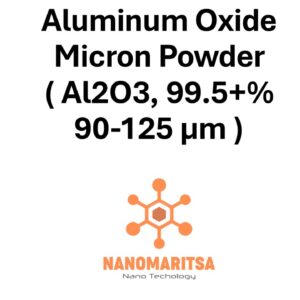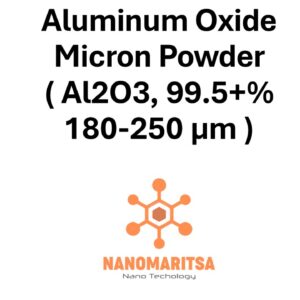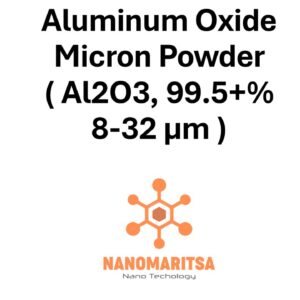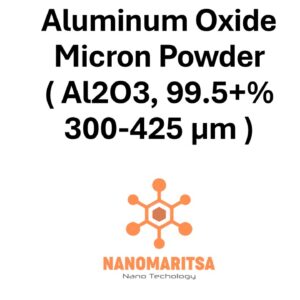Aluminum Oxide Micron Powder (Al₂O₃, 99.5+%, 1–10 μm) is a high-purity aluminum oxide powder known for its exceptional hardness, chemical stability, and thermal resistance. Often called alumina, Al₂O₃ is one of the most widely used oxide ceramics in both industrial and high-performance applications. Its ultrafine particle size (ranging from 1 to 10 micrometers) provides a significant surface area, making it ideal for processes requiring uniform dispersion and enhanced reactivity—such as advanced ceramics, polishing, and catalysis.
1. Key Properties
- High Purity (99.5+%)
Ensures minimal impurities that could compromise mechanical or chemical performance, particularly important for high-end ceramics, electronic substrates, and precision finishing. - Fine Particle Size (1–10 µm)
Enhances packing density and sinterability, promoting more uniform microstructures in advanced ceramics and facilitating smoother surfaces in polishing compounds. - Outstanding Hardness
As one of the hardest oxide materials, alumina ranks just below diamond on the Mohs scale, enabling its extensive use in wear-resistant components and abrasive media. - Thermal & Chemical Stability
With a melting point exceeding 2,000 °C and strong resistance to most acids and alkalis, aluminum oxide is well-suited for high-temperature, corrosion-prone environments. - Electrical Insulation
Alumina’s low electrical conductivity and high dielectric strength make it a common choice for insulators, circuit substrates, and protective coatings in the electronics sector.
2. Applications
- Advanced Ceramics & Refractories
Fine alumina powders are sintered to form dense ceramic parts—valves, seals, bearings, and kiln furniture—valued for their strength, temperature stability, and low wear rates. - Abrasives & Polishing
Alumina’s hardness makes it an excellent abrasive. Ultrafine alumina powders are employed in lapping and polishing optical components, semiconductor wafers, and metal surfaces. - Coatings & Thermal Barriers
In aerospace and power generation, alumina-based thermal barrier coatings protect metallic components from high temperatures, oxidation, and erosion. - Electronics & Substrates
Due to its high resistivity and dielectric properties, alumina is used for electronic substrates, insulating layers in microchips, and as a key material in sensors. - Catalysis & Filtration
High-purity alumina supports chemical catalysts (e.g., in refinery processes) and finds use in membranes for filtration systems that must withstand harsh chemical conditions.
3. Advantages
- Enhanced Sinterability
The 1–10 µm range provides an optimal balance of surface area and flowability, ensuring dense, homogeneous ceramic parts with minimal porosity after sintering. - Wear & Abrasion Resistance
Alumina’s extreme hardness prolongs the lifespan of tools, coatings, and components exposed to grinding, cutting, or erosive media. - High Thermal Conductivity (when dense)
While porosity and grain structure affect thermal conductivity, dense alumina can effectively dissipate heat in demanding applications like power electronics. - Chemically Inert
Alumina remains stable in acidic or alkaline conditions, reducing contamination and extending equipment longevity in chemical processing. - Dimensional Stability
Even under thermal cycling or in corrosive atmospheres, alumina maintains its structural integrity, making it a go-to material for precision components.
4. Recent Trends and Research
- Nano-Structured Ceramics
Researchers are investigating nanoscale alumina powders to produce parts with improved fracture toughness, greater density, and reduced sintering temperatures. - Advanced Coating Techniques
Plasma spray, HVOF (High-Velocity Oxy Fuel), and sol-gel methods are refined for applying alumina films that offer superior thermal and corrosion protection. - Additive Manufacturing (3D Printing)
Although alumina is primarily processed via traditional ceramic methods, progress in binder jetting and stereolithography has introduced new design possibilities for alumina-based parts. - Hybrid Composites
Combining alumina with other ceramics, metals, or carbon-based materials can yield composites featuring tailored electrical and mechanical properties (e.g., metal-matrix composites). - Clean Energy Solutions
Porous alumina supports are used in catalytic converters, fuel cells, and hydrogen production, aligning with global initiatives for greener, more efficient energy systems.
5. Future Prospects
- 3D Printed Ceramics
Refined additive manufacturing methods may produce complex alumina structures for aerospace, biomedical implants, and microfluidic devices, lowering production costs and waste. - High-Performance Electronics
As electronic devices demand higher operating temperatures and power densities, alumina’s insulating capabilities will remain critical in circuit packaging and thermal management. - Eco-Friendly Polishing
Efforts to replace harsh chemical polishes with alumina-based abrasives could lead to more sustainable semiconductor and optical manufacturing processes. - Biocompatible Composites
Alumina’s high wear resistance and chemical inertness support development of ceramic-on-ceramic implants and medical tools, improving patient outcomes and reducing allergic reactions. - Enhanced Structural Ceramics
Ongoing research into grain-boundary engineering may yield alumina ceramics with superior toughness and reliability for jet engine components, cutting tools, and beyond.
Through its 99.5+% purity, 1–10 µm particle size distribution, and excellent mechanical and chemical stability, Aluminum Oxide Micron Powder (Al₂O₃, 99.5+%, 1–10 μm) stands at the forefront of materials science for demanding applications. Whether it’s high-temperature components, electronics substrates, or precision polishing media, alumina’s versatility, durability, and reliability solidify its position as a cornerstone ceramic in modern industry.
| Measurement (gr) | 100 grams, 500 grams, 1000 grams |
|---|






